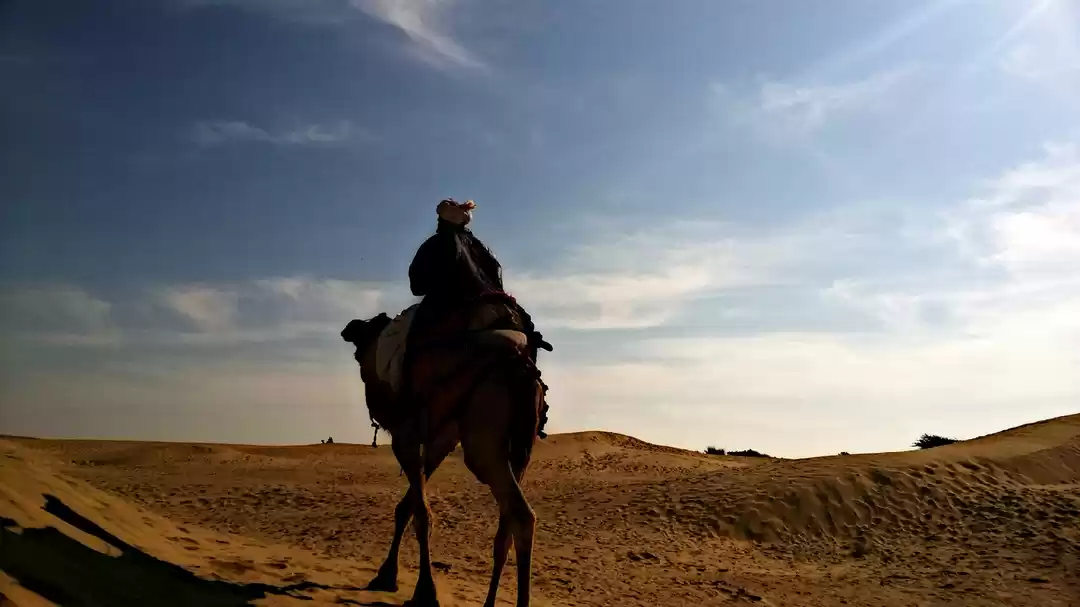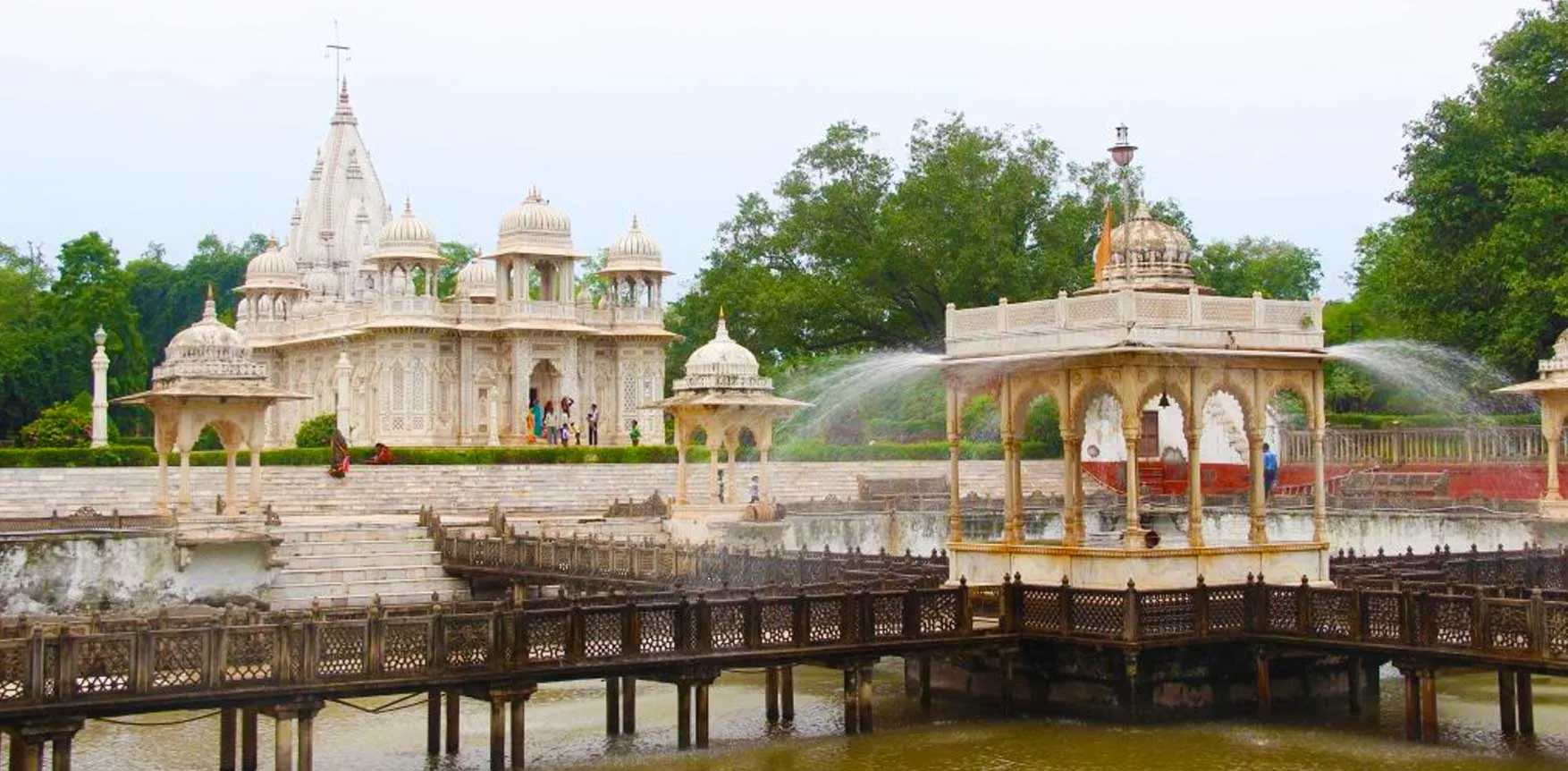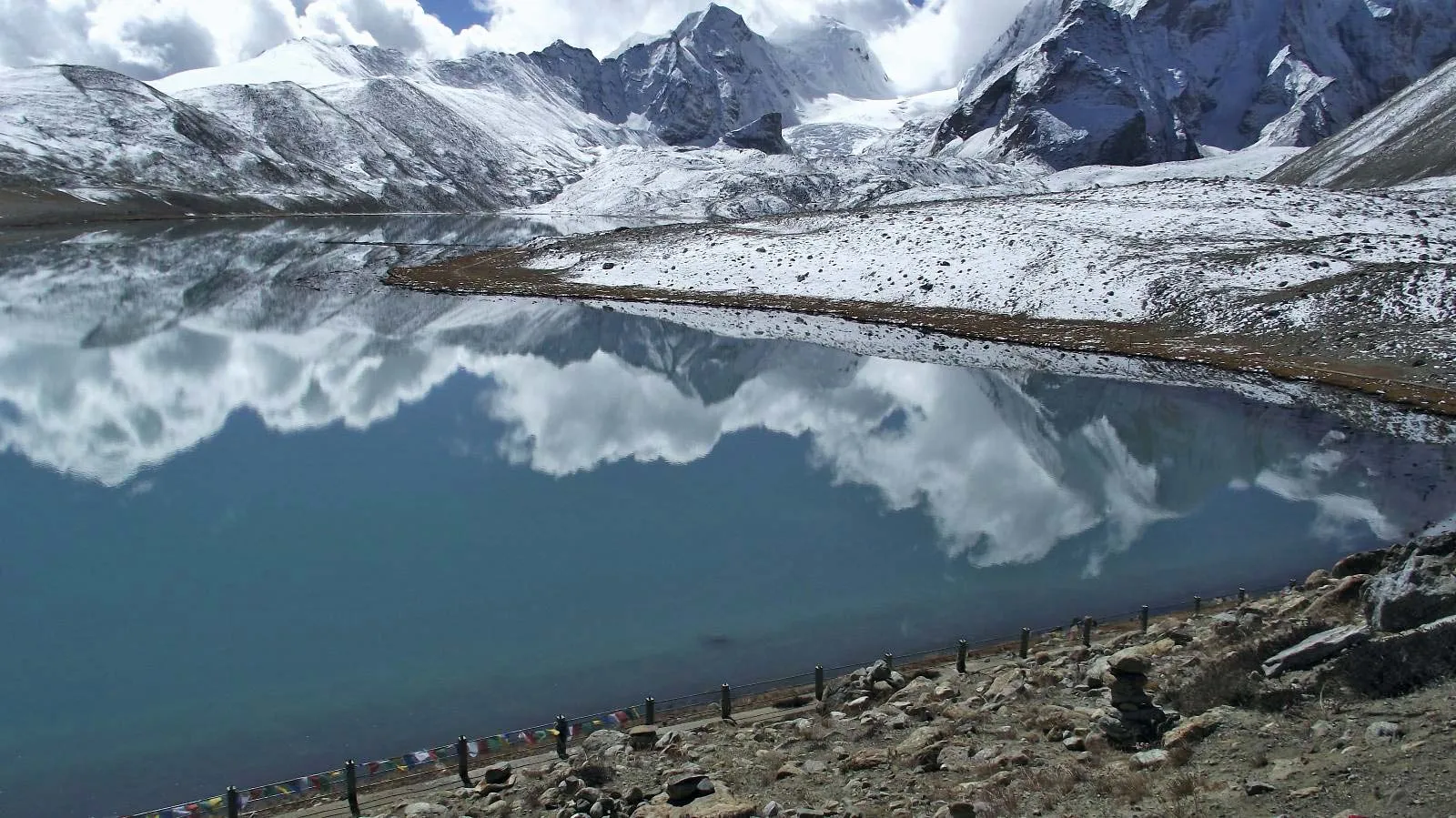Nestled in the lap of the Eastern Himalayas, Sikkim is a realm where tranquility meets adventure, offering a unique blend of serene landscapes and thrilling experiences. This small yet diverse state is home to verdant valleys, towering snow-capped peaks, and pristine lakes that mirror the skies. The calm of Sikkim’s monasteries and the gentle hum of prayer flags in the wind create an atmosphere of peace that is almost palpable. Visitors can lose themselves in the tranquil beauty of places like Tsomgo Lake, Yumthang Valley, and the age-old monasteries that dot the region, all while being embraced by the warm hospitality of the Sikkimese people.
For the adventure-seekers, Sikkim offers an array of activities that pump adrenaline into the serene setting. From trekking the challenging trails of Goecha La and Dzongri to river rafting on the Teesta, the state is a playground for those seeking thrills in nature. The landscape also provides opportunities for paragliding, mountain biking, and even yak safaris, making Sikkim a destination that caters to both the soul-seeker and the adventurer. Whether you come to find peace or to push your limits, Sikkim promises an unforgettable journey through one of India’s most enchanting states.
1. Tsomgo Lake
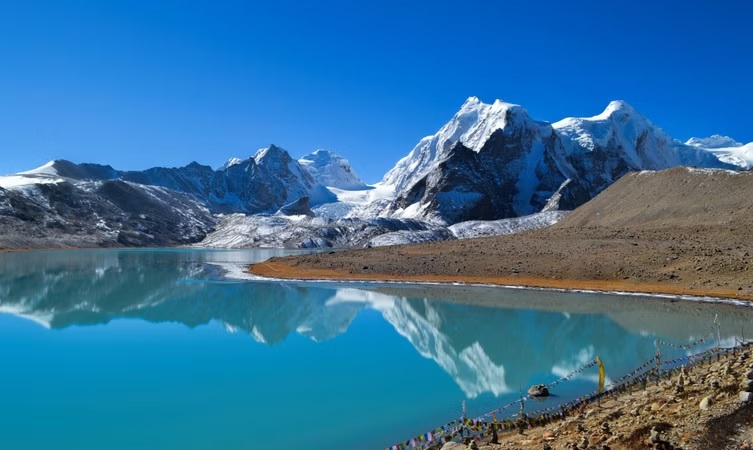
Tsomgo Lake, also known as Changu Lake, is one of Sikkim’s most breathtaking natural wonders. Located at an altitude of 3,753 meters (12,313 feet) above sea level, this glacial lake is situated around 40 kilometers (25 miles) from Gangtok, the capital of Sikkim. The lake is nestled in the rugged mountains and is surrounded by steep slopes covered in snow during winter and lush greenery in summer, making it a year-round attraction. The crystal-clear waters of Tsomgo Lake reflect the surrounding peaks, creating a serene and picturesque setting that captivates visitors.
Tsomgo Lake is not just a visual delight but also holds religious significance for the local people. It is considered sacred by the Sikkimese, and a small temple dedicated to Lord Shiva is located on the lake’s shores. During winter, the lake freezes, offering a unique spectacle of a frozen paradise. The area around the lake is also home to various species of birds, including the Brahminy duck and the red panda, making it a haven for nature lovers.
Location: Tsomgo Lake is situated approximately 40 kilometers from Gangtok, on the way to the Nathula Pass. The journey to the lake involves a scenic drive through winding mountain roads, with stunning views of the surrounding landscape.
Entry Fee: The entry fee for Tsomgo Lake is generally around INR 200 per person. However, since the lake is located near the India-China border, visitors are required to obtain a permit to visit. This permit can be arranged through local travel agencies or hotels in Gangtok. The permit fee is usually included in tour packages, but if arranged independently, it may cost an additional INR 200-300 per person.
2. Nathula Pass
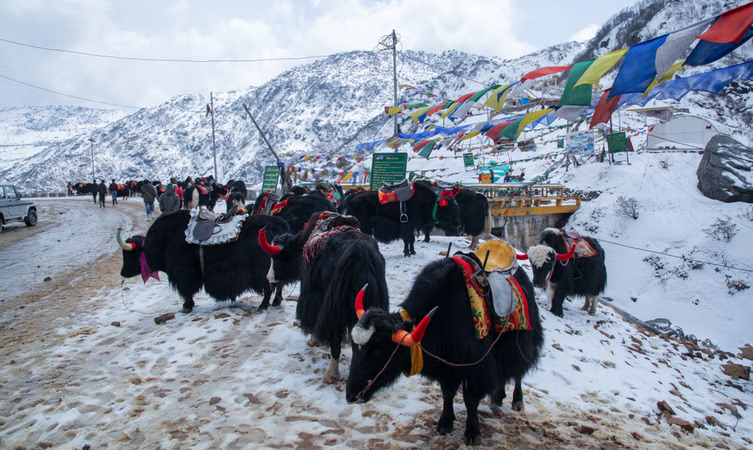
Nathula Pass is a strategically significant mountain pass in the Eastern Himalayas, located on the Indo-China border. Standing at an altitude of 4,310 meters (14,140 feet), it connects the Indian state of Sikkim with China’s Tibet Autonomous Region. The pass is a part of the historic Silk Route and has served as a critical trade route between India and Tibet. Today, Nathula is one of the few open border posts between India and China, and visiting this place offers a unique glimpse into the geopolitical significance of the region.
Nathula Pass is not just a political landmark but also a site of incredible natural beauty. The journey to the pass takes visitors through winding roads that offer panoramic views of the Eastern Himalayas. During winter, the pass is often covered in snow, creating a breathtaking landscape. At Nathula, visitors can witness the border gates of India and China, the barbed wire fences that separate the two nations, and even interact with soldiers from both sides. A visit to the war memorial dedicated to the Indian soldiers who lost their lives in the 1962 Sino-Indian conflict is also a poignant experience.
Location: Nathula Pass is located about 56 kilometers (35 miles) east of Gangtok, Sikkim’s capital. The journey to Nathula is an adventurous drive through steep and winding mountain roads, with several points offering stunning views of the surrounding peaks and valleys.
Entry Fee: To visit Nathula Pass, Indian citizens must obtain a special permit as the area falls under restricted access due to its proximity to the international border. The permit can be arranged through authorized travel agencies or hotels in Gangtok. The cost of the permit is generally around INR 200 per person, with an additional fee of INR 200-300 for transportation to Nathula. It’s important to note that Nathula Pass is closed to foreign nationals, and even for Indian citizens, visits are allowed only on certain days (usually Wednesday, Thursday, Saturday, and Sunday), subject to weather conditions and security clearances.
3. Kanchenjunga Base Camp
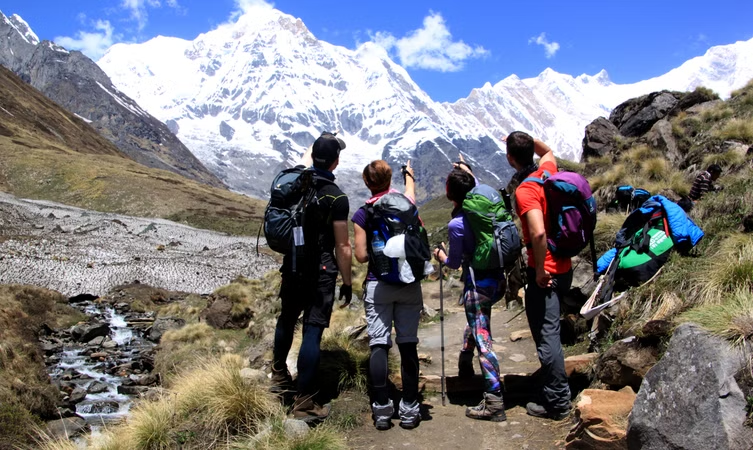
Kanchenjunga Base Camp offers adventurers a chance to experience the majesty of Kanchenjunga, the third-highest peak in the world, standing at 8,586 meters (28,169 feet). The base camp is a dream destination for trekking enthusiasts, providing an up-close view of the towering Kanchenjunga massif and the surrounding Himalayan peaks. The trek to Kanchenjunga Base Camp is an exhilarating journey through remote and pristine landscapes, characterized by dense forests, alpine meadows, glacial rivers, and traditional villages that offer a glimpse into the rich culture of the region.
The trek begins from Yuksom, a small town in West Sikkim, and passes through several picturesque locations such as Bakkhim, Tshoka, Dzongri, Thangsing, and Lamuney before reaching the base camp. Along the way, trekkers can witness breathtaking views of the Kanchenjunga range, including Mt. Pandim, Mt. Kabru, and Mt. Siniolchu. The trail also takes trekkers through the Kanchenjunga National Park, a UNESCO World Heritage Site known for its diverse flora and fauna, including the elusive snow leopard, red panda, and various species of birds. The journey to Kanchenjunga Base Camp is not just a trek but an adventure into one of the most untouched and sacred regions of the Himalayas.
Location: The Kanchenjunga Base Camp trek starts from Yuksom in West Sikkim, which is about 145 kilometers (90 miles) from Gangtok, the capital of Sikkim. Yuksom is accessible by road from Gangtok or from Bagdogra Airport, the nearest airport, located about 160 kilometers (99 miles) away. The base camp itself is located at an altitude of approximately 5,143 meters (16,873 feet).
Entry Fee: To trek to Kanchenjunga Base Camp, trekkers need to obtain several permits:
- Kanchenjunga National Park Entry Permit: Since the trek passes through the Kanchenjunga National Park, an entry permit is required, which costs around INR 200 per person for Indian nationals and INR 500 per person for foreign nationals.
4. Yumthang Valley of Flowers
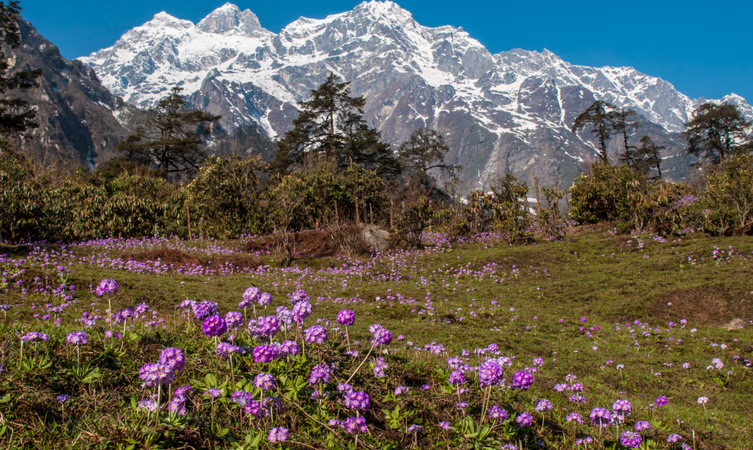
Yumthang Valley, often referred to as the “Valley of Flowers,” is a stunning natural sanctuary in North Sikkim, known for its breathtaking beauty and vibrant floral diversity. Situated at an elevation of 3,564 meters (11,693 feet), Yumthang is a vast expanse of lush meadows surrounded by towering Himalayan peaks, with the shimmering waters of the Yumthang River flowing through it. The valley is most famous for its incredible display of rhododendrons, which bloom in various colors during spring, painting the landscape in shades of red, pink, purple, and white. Apart from rhododendrons, the valley is home to over 24 species of orchids and a variety of other alpine flowers, making it a botanist’s paradise.
The best time to visit Yumthang Valley is between late February and mid-June, when the flowers are in full bloom, and the valley is transformed into a vibrant tapestry of colors. In addition to its floral beauty, Yumthang is also a great destination for those seeking peace and tranquility, offering visitors a chance to immerse themselves in the serene beauty of nature. The nearby Shingba Rhododendron Sanctuary further enhances the appeal of this magical valley, and visitors can also enjoy the soothing experience of the Yumthang Hot Springs, known for their therapeutic properties.
Location: Yumthang Valley is located about 140 kilometers (87 miles) north of Gangtok, the capital of Sikkim. The nearest town is Lachung, which is around 25 kilometers (15 miles) away and serves as the base for exploring the valley. The journey to Yumthang from Gangtok is a scenic drive that takes you through winding mountain roads, dense forests, and picturesque villages.
Entry Fee: There is no specific entry fee for visiting Yumthang Valley itself. However, since the valley is located in a restricted area near the Indo-China border, visitors need to obtain a special permit known as the Inner Line Permit (ILP) to travel to Yumthang. This permit can be arranged through local travel agencies or hotels in Gangtok and typically costs around INR 200 per person. Additionally, you may need to pay a nominal fee to enter the Shingba Rhododendron Sanctuary if you choose to explore it.
5. Gurudongmar Lake
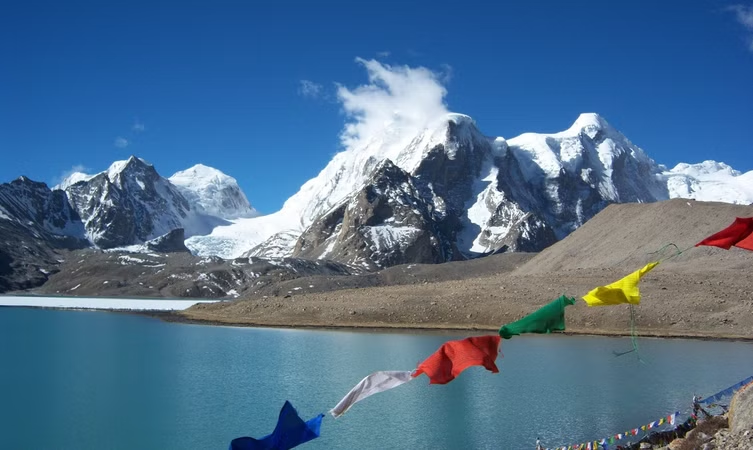
Gurudongmar Lake is one of the highest lakes in the world, situated at an altitude of 5,430 meters (17,818 feet) in North Sikkim. This pristine glacial lake is revered by both Hindus and Buddhists, with local legends attributing its sacred status to Guru Padmasambhava (Guru Rinpoche), the founder of Tibetan Buddhism. The lake is surrounded by rugged mountain terrain and offers breathtaking views of the majestic peaks, including the Kanchenjunga range.
The lake’s unique beauty lies in its crystal-clear waters that reflect the snow-capped mountains, and its spiritual significance adds to the allure of this remote destination. Despite its high altitude, the lake remains accessible throughout the year, though visiting conditions can vary based on weather.
Location: Gurudongmar Lake is located about 170 kilometers (105 miles) from Gangtok, the capital of Sikkim. The journey to the lake involves a scenic drive through the rugged terrain of North Sikkim, typically starting from Lachen, a small town located around 30 kilometers (19 miles) from the lake. The drive to Gurudongmar Lake is an adventurous one, with breathtaking views of the Himalayan landscape.
Entry Fee: As Gurudongmar Lake is located in a restricted area near the Indo-China border, visitors are required to obtain a special permit. The permits needed include:
- Inner Line Permit (ILP): This permit is required for Indian nationals to visit Gurudongmar Lake. The permit can be arranged through authorized travel agencies or hotels in Gangtok. The cost of the ILP is usually around INR 200 per person.
6. Goechala
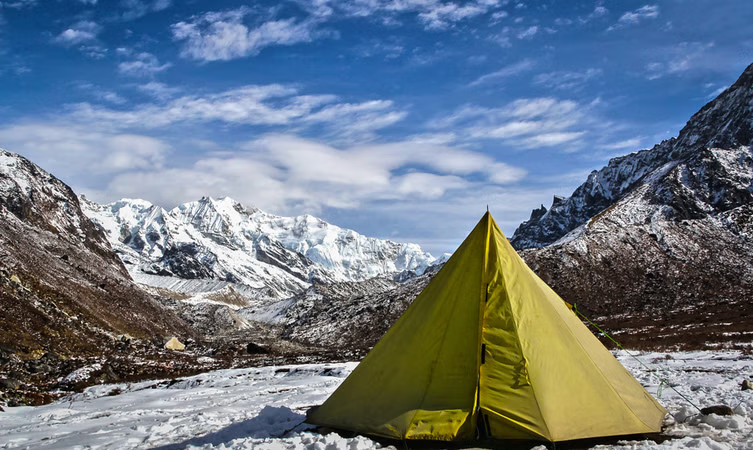
Goechala is a high-altitude trekking destination renowned for its spectacular views of the Kanchenjunga massif, the third-highest peak in the world. Situated at an elevation of 4,940 meters (16,207 feet), Goechala offers breathtaking panoramas of the Himalayan range and a challenging trekking experience. The trek to Goechala takes you through diverse landscapes, including lush rhododendron forests, alpine meadows, and glacial moraines, making it a visual feast for nature lovers and adventure seekers alike.
The trek typically starts from Yuksom, a quaint town in West Sikkim, and follows a trail that passes through beautiful locations such as Bakkhim, Tshoka, Dzongri, Thangsing, and Lamuney before reaching the Goechala viewpoint. Along the way, trekkers can enjoy stunning views of various Himalayan peaks, including Mt. Kanchenjunga, Mt. Pandim, Mt. Kabru, and Mt. Siniolchu. The trek also provides an opportunity to experience the rich flora and fauna of the Kanchenjunga National Park, a UNESCO World Heritage Site.
Location: Goechala is located in West Sikkim, with the trek starting from Yuksom, which is about 145 kilometers (90 miles) from Gangtok, the capital of Sikkim. The trek to Goechala generally takes around 10-12 days, depending on the itinerary and pace.
Entry Fee: To trek to Goechala, trekkers need to obtain the following permits:
- Kanchenjunga National Park Entry Permit: This permit is required as the trek passes through Kanchenjunga National Park. The fee is approximately INR 200 per person for Indian nationals and INR 500 per person for foreign nationals.
7. Singalila
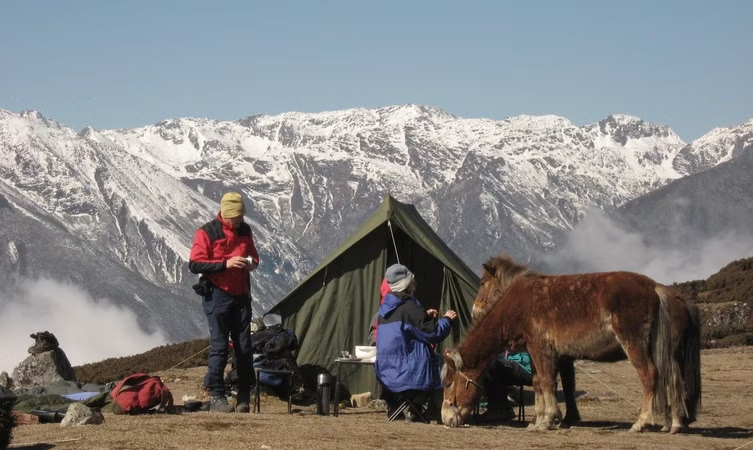
The Singalila Ridge is a renowned trekking destination known for its stunning views of the Himalayan peaks and lush landscapes. It forms part of the Singalila National Park, which is situated in the Darjeeling district of West Bengal, India. The ridge is famous for its panoramic vistas of the world’s highest peaks, including Mount Everest, Kanchenjunga, Makalu, and Lhotse. The trek along the Singalila Ridge offers a unique combination of natural beauty, diverse flora and fauna, and cultural experiences with local communities.
The trek generally starts from the small town of Maneybhanjang, which serves as the gateway to the Singalila Ridge. From there, trekkers ascend through beautiful rhododendron forests, quaint villages, and terraced fields to reach the various viewpoints along the ridge. The trail takes you to popular spots like Sandakphu and Phalut, which offer some of the best views of the Himalayan range. The trek is known for its moderate difficulty level and is ideal for those seeking both adventure and tranquility.
Location: Singalila Ridge is located in the Darjeeling district of West Bengal, India. The trek starts from Maneybhanjang, which is about 30 kilometers (19 miles) from Darjeeling. The trail continues through the Singalila National Park, eventually reaching the high-altitude viewpoints of Sandakphu and Phalut. The total trek usually takes around 8-10 days, depending on the itinerary and pace.
Entry Fee: To trek in Singalila National Park, you need to obtain the following permits:
- Singalila National Park Entry Permit: This permit is required to enter the national park area. The fee is approximately INR 100 per person for Indian nationals and INR 500 per person for foreign nationals.
8. Green Lake
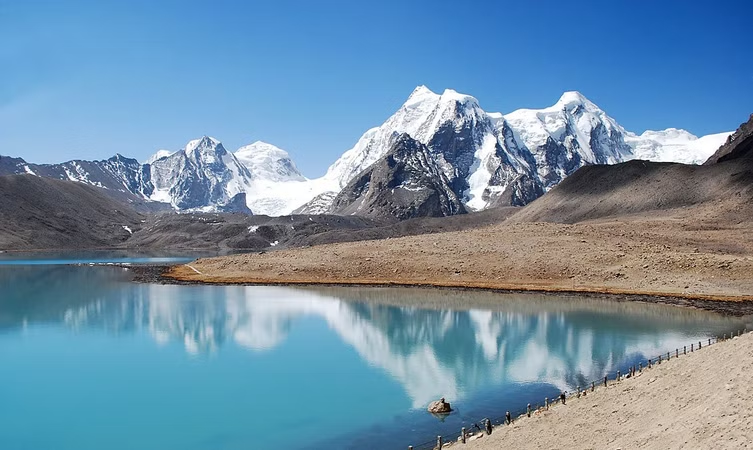
Green Lake is a lesser-known but stunning trekking destination in Sikkim, offering a unique experience for those seeking tranquility and breathtaking natural beauty. Located at an elevation of around 4,800 meters (15,748 feet), Green Lake is situated in the remote and picturesque valley of the Kanchenjunga range. The lake is named for its vibrant green color, which is a result of the algae and mineral content in the water. The surrounding landscape is marked by pristine alpine meadows, rugged terrain, and views of the snow-capped peaks of the Eastern Himalayas.
The trek to Green Lake starts from Yuksom, a small town in West Sikkim, and follows a less-traveled route compared to other popular treks in the region. Trekkers pass through dense forests, charming villages, and picturesque landscapes before reaching the lake. The trek is known for its challenging terrain and high-altitude conditions, making it suitable for experienced trekkers seeking an off-the-beaten-path adventure.
Location: Green Lake is located in the Kanchenjunga National Park in West Sikkim, India. The trek to the lake begins from Yuksom, which is approximately 145 kilometers (90 miles) from Gangtok, the capital of Sikkim. The trek itself typically takes around 12-15 days to complete, depending on the itinerary and pace.
Entry Fee: To trek to Green Lake, trekkers need to obtain the following permits:
- Kanchenjunga National Park Entry Permit: As Green Lake is located within the Kanchenjunga National Park, an entry permit is required. The fee is approximately INR 200 per person for Indian nationals and INR 500 per person for foreign nationals.
9. Lachung
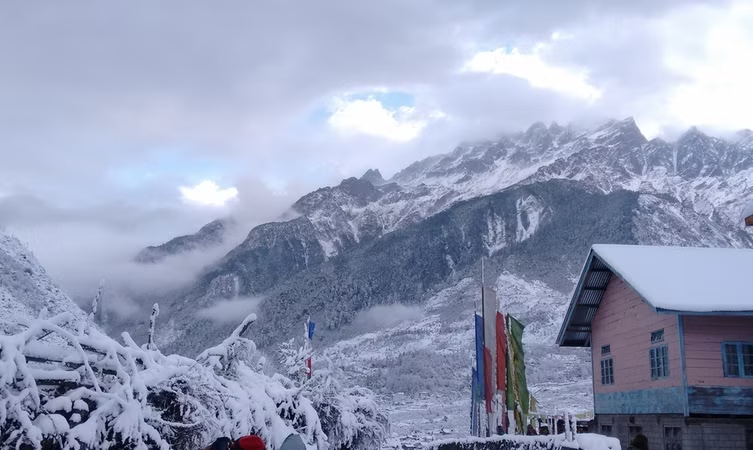
Lachung is a charming village located in North Sikkim, nestled in the lap of the Eastern Himalayas. Situated at an elevation of approximately 2,700 meters (8,858 feet), Lachung is renowned for its scenic beauty and serene environment. The village is surrounded by snow-capped peaks, lush green valleys, and terraced fields, making it a popular destination for tourists seeking a tranquil retreat.
Lachung serves as a base for exploring nearby attractions such as Yumthang Valley and Gurudongmar Lake. The village is known for its vibrant local culture, traditional Sikkimese architecture, and warm hospitality. Visitors can experience the charm of Lachung by wandering through its picturesque streets, interacting with the friendly locals, and enjoying the local cuisine.
Location: Lachung is located about 125 kilometers (78 miles) from Gangtok, the capital of Sikkim. The drive from Gangtok to Lachung takes approximately 6-8 hours, passing through winding mountain roads and offering stunning views of the Himalayan landscape. Lachung is situated along the Lachung River, which adds to its scenic charm.
Entry Fee: Lachung is located in a restricted area due to its proximity to the Indo-China border, so visitors need to obtain a special permit to visit. The permits required include:
- Inner Line Permit (ILP): Indian nationals require an ILP to visit Lachung. This permit can be arranged through local travel agencies or hotels in Gangtok. The cost is typically around INR 200 per person.
10. Pelling

Pelling is a picturesque town in West Sikkim, known for its stunning views of the Kanchenjunga range and its serene, tranquil environment. Located at an altitude of approximately 2,150 meters (7,054 feet), Pelling offers a variety of attractions including monasteries, waterfalls, and scenic viewpoints. It serves as a popular base for tourists exploring the nearby areas of West Sikkim.
The town is famous for its panoramic views of the Himalayan peaks, including the majestic Kanchenjunga, the third-highest peak in the world. Key attractions in and around Pelling include the Pemayangtse Monastery, the Khecheopalri Lake, the Rimbi Waterfalls, and the Kanchenjunga Falls. The town’s pleasant climate and stunning natural beauty make it a favored destination for both nature lovers and adventure enthusiasts.
Location: Pelling is located about 115 kilometers (71 miles) from Gangtok, the capital of Sikkim. The drive from Gangtok to Pelling takes approximately 4-6 hours, depending on road conditions. Pelling is situated in the foothills of the Himalayas, offering sweeping views of the surrounding mountains and valleys.
Entry Fee: Pelling itself does not have a specific entry fee. However, some of the attractions around Pelling may have their own entry fees:
- Pemayangtse Monastery: Entry to the monastery is usually free, but a small donation is appreciated.
- Khecheopalri Lake: There may be a nominal fee for visiting the lake, generally around INR 50 per person.
11. Zuluk
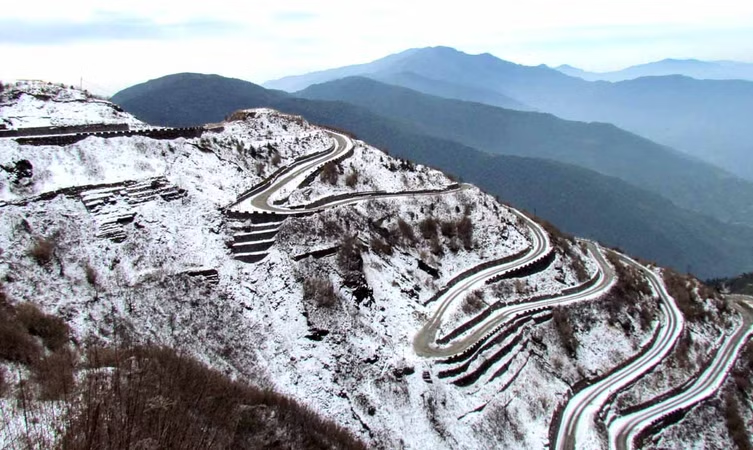
Zuluk is a quaint and scenic village located in East Sikkim, renowned for its spectacular views of the Eastern Himalayas and its unique terrain. Positioned at an altitude of approximately 2,400 meters (7,874 feet), Zuluk offers a peaceful retreat with panoramic vistas of snow-capped peaks, rolling hills, and lush landscapes. The village is situated along the Old Silk Route, a historic trade route connecting India with Tibet, and is known for its meandering roads and picturesque surroundings.
One of the main attractions of Zuluk is the famous zigzag road known as the “Zuluk Loop,” which features a series of hairpin bends and offers breathtaking views of the surrounding mountains. The village is also a gateway to exploring nearby destinations such as the Thambi Viewpoint, which provides stunning views of the Kanchenjunga range, and the Babamoo, a local religious site. Zuluk is an ideal destination for those seeking tranquility and natural beauty away from the more touristy spots.
Location: Zuluk is located about 100 kilometers (62 miles) from Gangtok, the capital of Sikkim. The drive from Gangtok to Zuluk takes approximately 5-7 hours, with the journey passing through winding mountain roads and offering scenic views. The village is situated in the eastern part of Sikkim, close to the Indo-China border.
Entry Fee: Zuluk is located in a restricted area due to its proximity to the Indo-China border, so visitors need to obtain special permits:
- Inner Line Permit (ILP): Indian nationals require an ILP to visit Zuluk. This permit can be arranged through local travel agencies or hotels in Gangtok. The cost of the ILP is generally around INR 200 per person.
12. Ravangla
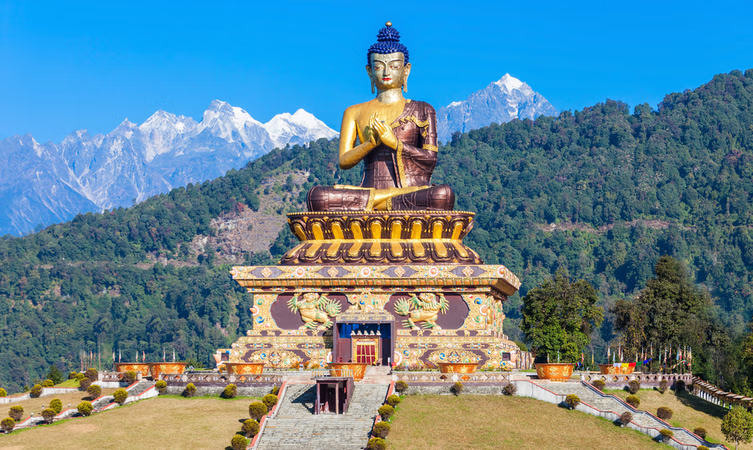
Ravangla is a tranquil town in South Sikkim, known for its stunning natural beauty and panoramic views of the Himalayan peaks. Situated at an altitude of approximately 2,100 meters (6,890 feet), Ravangla offers a peaceful retreat with lush greenery, picturesque landscapes, and a pleasant climate. The town serves as a great base for exploring nearby attractions and enjoying the serenity of the Eastern Himalayas.
Key attractions in and around Ravangla include:
- Buddha Park of Ravangla: This iconic park features a massive statue of Buddha, which stands at 130 feet. The park offers beautiful gardens, walking paths, and panoramic views of the surrounding mountains.
- Ralong Monastery: A significant Tibetan Buddhist monastery located near Ravangla, known for its beautiful architecture and religious significance.
- Khecheopalri Lake: Often referred to as the “Wishing Lake,” this sacred lake is located a short drive from Ravangla and is surrounded by lush forests.
- Maenam Hill: Offers breathtaking views of the Himalayas and is ideal for trekking and nature walks.
Location: Ravangla is located about 80 kilometers (50 miles) from Gangtok, the capital of Sikkim. The drive from Gangtok to Ravangla takes approximately 3-4 hours, passing through scenic mountain roads and picturesque villages. Ravangla is situated in the southern part of Sikkim, offering views of the Kanchenjunga range and surrounding peaks.
Entry Fee: Ravangla itself does not have a specific entry fee. However, some of the attractions around Ravangla may have their own entry fees:
- Buddha Park of Ravangla: Entry to the park is generally free, but a nominal fee may be charged for photography or special events. The fee is usually around INR 30 per person.
13. Rumtek Monastery
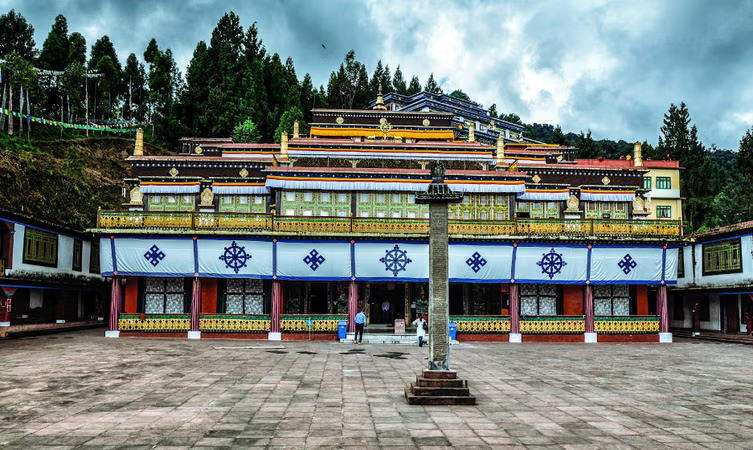
Rumtek Monastery, also known as the Dharma Chakra Centre, is one of the most important Tibetan Buddhist monasteries in Sikkim. Located at an altitude of about 1,640 meters (5,380 feet), it is renowned for its significant religious and cultural heritage. The monastery was originally built in the 16th century by the 9th Karmapa, Wangchuk Dorje, and was later rebuilt in its current form in the 1960s under the guidance of the 16th Karmapa, Rangjung Rigpe Dorje.
The monastery is a major center for Tibetan Buddhism and serves as the seat of the Karmapa in exile. It is renowned for its beautiful architecture, vibrant murals, and impressive statues, including a large statue of the Buddha. The monastery complex also houses a meditation hall, a library, and a school for monks. The serene environment and the stunning views of the surrounding hills make Rumtek Monastery a popular destination for visitors seeking spiritual solace and cultural insight.
Location: Rumtek Monastery is located about 24 kilometers (15 miles) from Gangtok, the capital of Sikkim. The drive from Gangtok to Rumtek takes approximately 45 minutes to 1 hour, passing through scenic landscapes and local villages. The monastery is situated on a hilltop, providing panoramic views of the surrounding area.
Entry Fee: Visiting Rumtek Monastery generally does not require an entry fee. However, there may be a small fee for photography, which is typically around INR 50 per camera. Visitors are also encouraged to make a voluntary donation to support the monastery and its activities
14. Yuksom
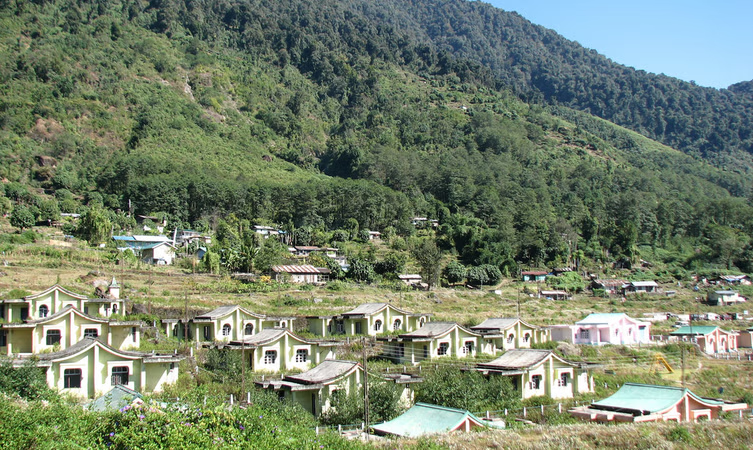
Yuksom is a historic town located in West Sikkim, known for its rich cultural heritage and as the starting point for several popular treks in the region. Situated at an elevation of about 1,780 meters (5,840 feet), Yuksom is surrounded by lush greenery, terraced fields, and stunning views of the Eastern Himalayas. The town is renowned for its historical significance as the place where the first Chogyal (king) of Sikkim was crowned in 1642, marking the beginning of the Sikkimese monarchy.
Yuksom serves as a key base for trekkers heading to destinations such as the Kanchenjunga Base Camp and Dzongri. The town is also known for its serene environment, traditional Sikkimese architecture, and local monasteries. Visitors to Yuksom can explore attractions like the Norbugang Park, which commemorates the coronation of the first Chogyal, and the Khamdong Monastery, which adds to the cultural charm of the town.
Location: Yuksom is located about 145 kilometers (90 miles) from Gangtok, the capital of Sikkim. The drive from Gangtok to Yuksom takes approximately 6-8 hours, passing through winding mountain roads and picturesque landscapes. The town is situated in the western part of Sikkim, making it a convenient starting point for treks and explorations in the region.
Entry Fee: Yuksom itself does not have a specific entry fee. However, visitors to certain attractions in and around Yuksom may encounter the following fees:
15. Teesta River
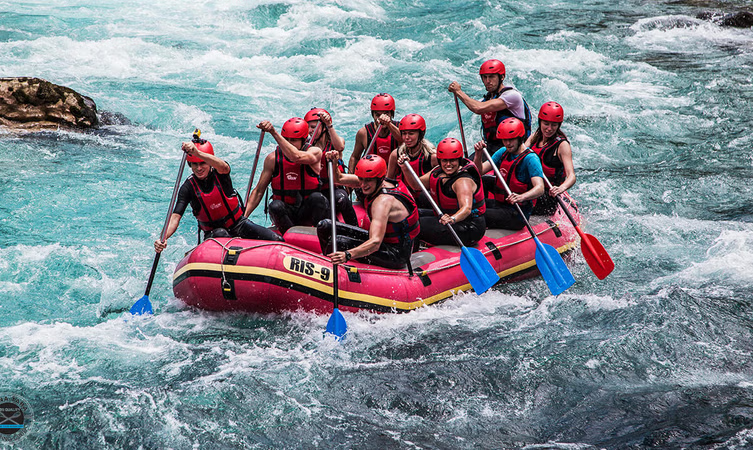
The Teesta River is one of the major rivers flowing through the Indian states of Sikkim and West Bengal. Originating from the Himalayan glaciers in North Sikkim, the river traverses through lush valleys and picturesque landscapes before merging with the Brahmaputra River in Bangladesh. The Teesta River is known for its clear, blue waters and is a popular destination for tourists seeking natural beauty and adventure.
The river is a central feature in many local activities, including white-water rafting, which is a popular adventure sport in the region. The river’s banks are adorned with scenic spots that offer breathtaking views and opportunities for relaxation and photography. The surrounding areas, especially near the towns of Gangtok and Rangpo in Sikkim, provide beautiful settings for picnics, nature walks, and other outdoor activities.
Location: The Teesta River flows through North Sikkim, West Sikkim, and parts of West Bengal. It originates from the glaciers in the eastern Himalayas and meanders through the state of Sikkim before continuing its journey through West Bengal. Key spots to visit along the river in Sikkim include:
- Teesta Bazaar: Located near the town of Rangpo, Teesta Bazaar is a popular spot for tourists to view the river and enjoy the surrounding landscape.
- Gangtok: The capital city of Sikkim, Gangtok, is situated along the river and offers various viewpoints and activities related to the Teesta River.
Entry Fee: There is generally no specific entry fee for visiting the Teesta River itself. However, if you plan to engage in activities such as white-water rafting or other organized tours, there may be associated costs:
- White-Water Rafting: This activity is popular on the Teesta River, particularly between Melli and Rangpo. The cost for white-water rafting can vary based on the duration and the service provider, typically ranging from INR 1,500 to INR 3,000 per person.
Top 5 Places For Shopping In Sikkim
Sikkim is largely inhabited by three ethnic groups – Lepcha, Nepali and Bhutia who practice different culture. Whether you are planning for a trip to the or South, the multicultural aspect of Sikkim has given birth to a number of things – food, costumes and festivals. In order to enjoy the best of these diversities, we suggest you try shopping in Sikkim. The marketplaces in Sikkim offer a host of assortments – all things ranging from traditional dress to handmade pickles. Check out these 5 best shopping destinations in Sikkim for a fantastic experience –
1. MG Road
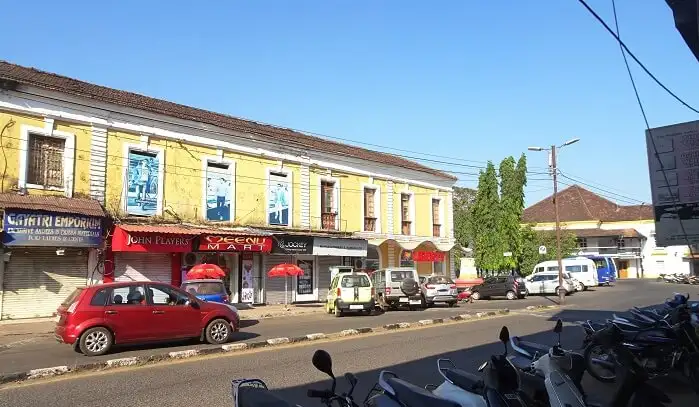
One of the main commercial areas of Sikkim, MG Road in Sikkim is located in MG Marg, Gangtok. It is an open mall in the heart of the city, and acts as the hotspot for all major shops, restaurants etc. in Gangtok. MG Road is largely famous for traditional Sikkimese cups, Thangkas and Choksi table designs. Apart from that, you can also shop for garments, souvenirs, trinkets, accessories, footwear and more. It is surely one of the best places for handicrafts shopping at Sikkim. Drop in anytime of the day before 7 p.m.
Location: MG Marg, Gangtok, Sikkim, India
2. Lal Bazaar
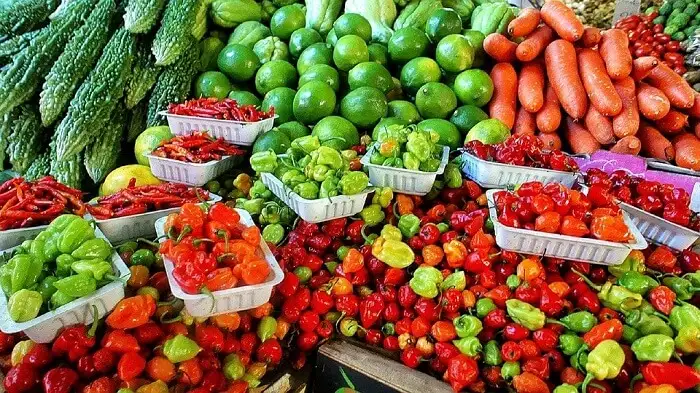
Located in East Sikkim, Lal Bazaar is fondly known as the soul of Sikkims kitchen. It is the best place to shop for organic and farm products. The produce are sold fresh from the market by local villagers. Take a walk down the streets of this flea market to shop for dried fish and exotic eatables. You can also take a detour to the nearby posh shopping arena – MG Road.
Location: Vishal Gaon, Gangtok, Sikkim
3. New Market
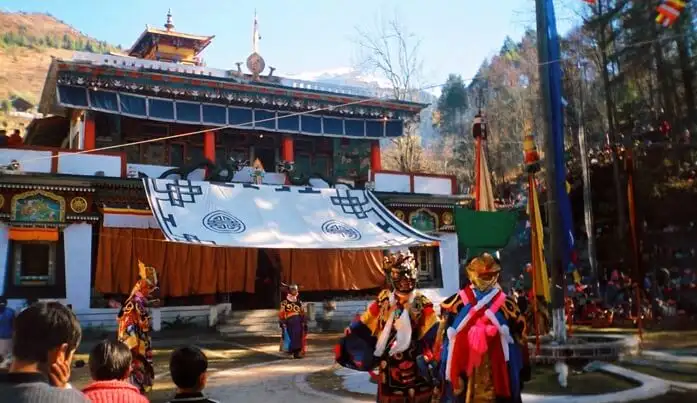
If you want to go for shopping in Sikkim Gangtok, then this is where you should come. New Market is considered to be one of the most popular shopping places in Sikkim. It is a bustling little market place in the main area of Gangtok. Some of the best items to buy from New Market are dry fruits, barfis and sweet mango peels. A lot of tourists come here to shop for the dried mango peels which can be carried back home.
Location: Near MG Marg, Vishal Gaon, Gangtok, Sikkim
4. Old Market
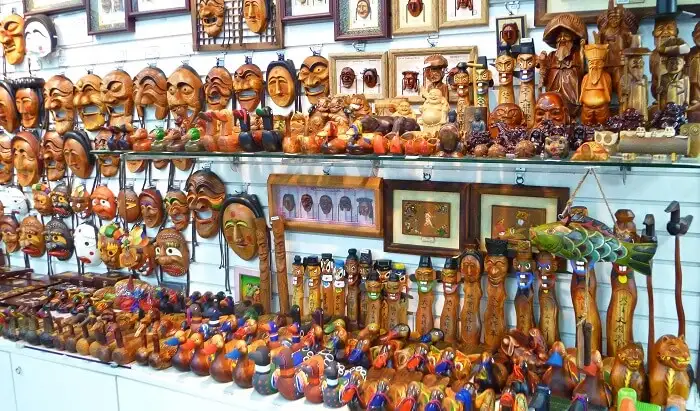
It is one of the liveliest shopping places in Sikkim. Located in MG Marg, Old Market is famous for fashion wear and accessories. Old Market is always buzzing with the overwhelming tone of tourists who bargain for a good deal. Make sure to check out the sets of Dogra jewellery and handicrafts that are sold here. You can also shop for walnuts and almonds which are again a best-seller here.
Location: Near MG Marg, Gangtok, Sikkim
5. Directorate of Handicrafts & Handlooms

Located at the furthermost edge of Tibet Road, Directorate of Handicrafts & Handlooms is famous for its distinct, large Sales Emporium. This is one of the best shopping destinations in Sikkim if you are looking for authentic Sikkimese handcrafted items and artwork. Local artisans and craftsmen are engaged to create these fine traditional products. You can find stunning Thangkas, artistic wood carvings, decorative wall hangings, soft woollen carpets and more.
Location: Zero Point, NH 31 A, Gangtok, Sikkim 737101
famous food in sikkim
- momos
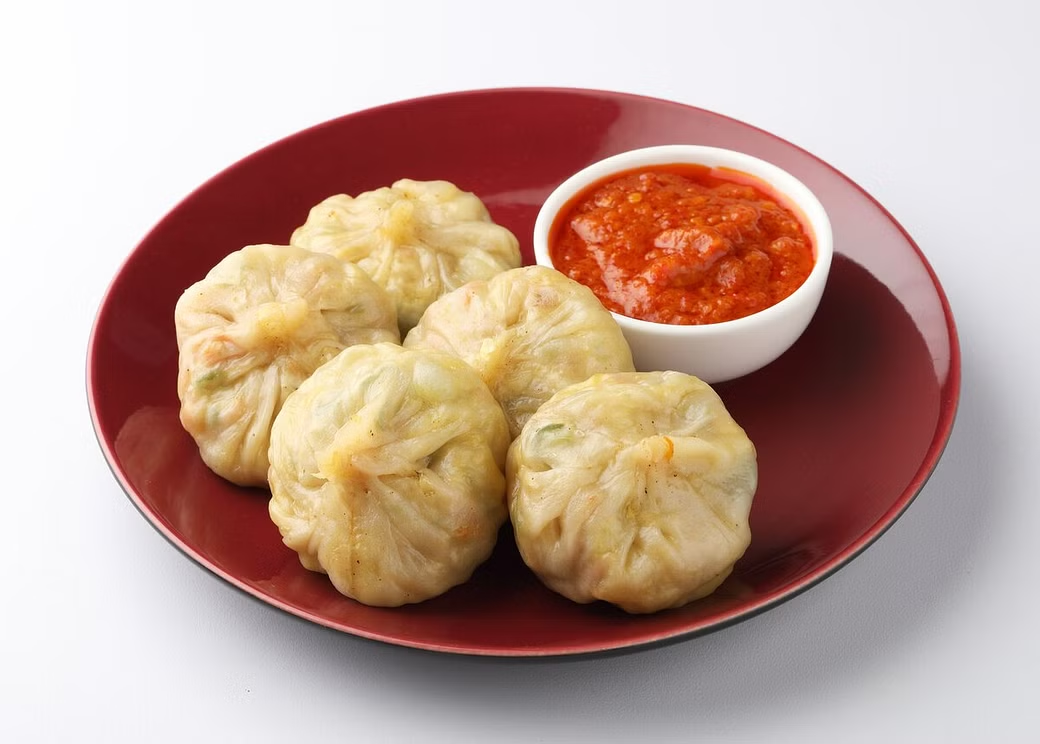
These steamed dumplings are made from a thin dough with various ingredients such as vegetables, chicken, or pork. The filling is seasoned with garlic, ginger, onion, and other spices. Momo is typically served with a spicy chutney, which is made from tomatoes, garlic, and red chillies. These delicious dumplings are enjoyed as a snack or a meal and are available in restaurants, cafes, and street food stalls throughout Sikkim. Momo are a famous Sikkim food originating from Tibetan cuisine.
MG Road, Gangtok: The main commercial street in Gangtok is lined with vendors selling various types of momos.
2. Thukpa
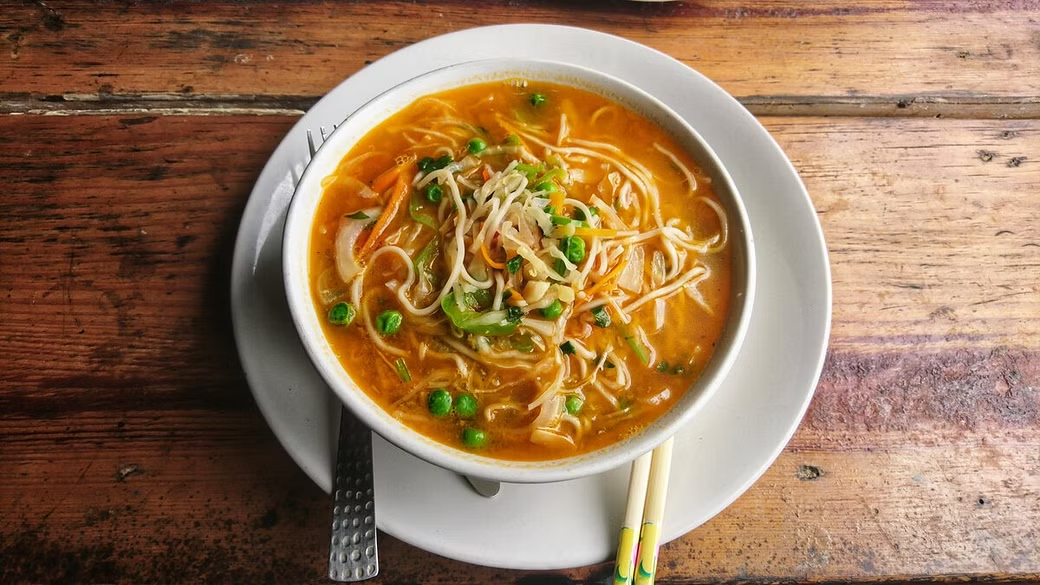
Thukpa is a comforting noodle soup that is a traditional Sikkim food. It consists of noodles, vegetables, or meat cooked in a flavourful broth made from onions, garlic, ginger, and various spices. Thukpa can be customized to include different ingredients, such as chicken, beef, or pork, and is often garnished with fresh herbs like cilantro or green onions. This hearty soup is enjoyed as a main course, providing warmth and nourishment during the cold winter months in Sikkim.
Lal Market, Gangtok: A good place to try this delicious noodle soup.
3. Gundruk
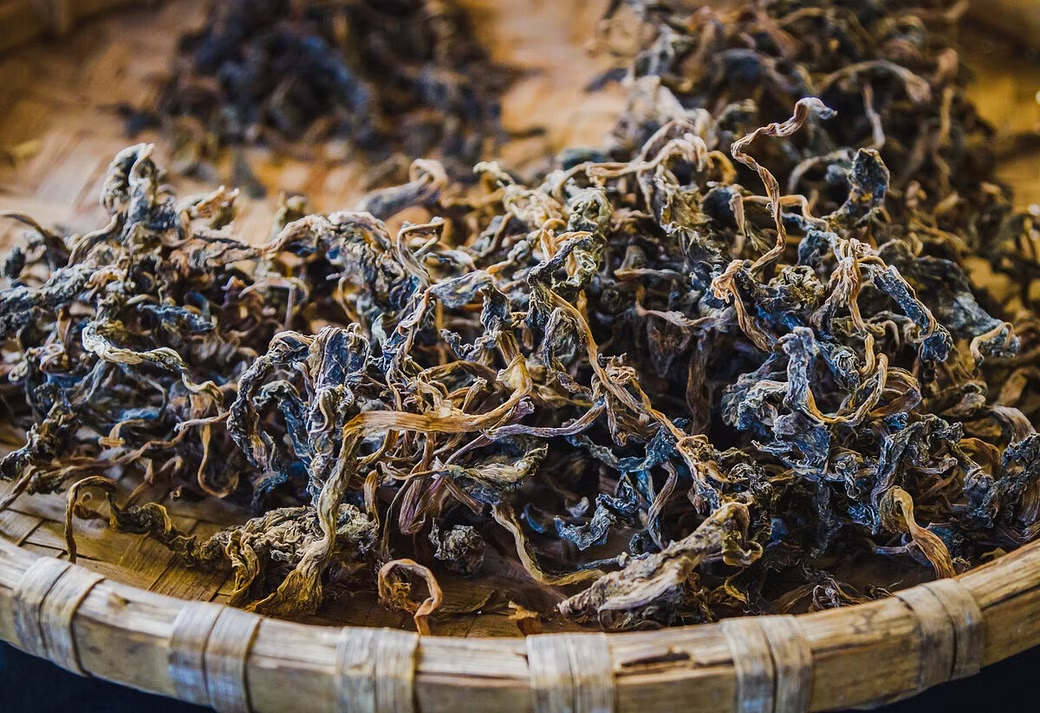
Gundruk is a traditional Nepali dish made from fermented leafy veg, mustard or radish leaves. The leaves are sun-dried and fermented for several days, resulting in a tangy, slightly sour flavour. Gundruk is used as an ingredient in soups, stews, or stir-fries, providing a unique taste and aroma. It is a good source of nutrients and is said to have health benefits due to the fermentation process. Gundruk is a staple food of Sikkim cuisine, enjoyed by locals and tourists alike.
Gangtok: Available in local markets and traditional eateries.
4. Kinema

Kinema is a traditional fermented soybean dish from Sikkim. Soybeans are boiled, drained, and then fermented for several days, resulting in a sticky, pungent mixture. Kinema is rich in protein, vitamins, and minerals, making it a nutritious addition to meals. It is often served as a side dish with rice or used as a base for curry. The unique flavour and aroma of kinema may take some getting used to
Gangtok Market: Local markets often sell Kinema.
5. Churpi

Chhurpi is a traditional cheese made from cow or yak milk and is available in two varieties: soft and hard. Soft chhurpi, also known as “chhurpi ningro”, is a fresh cheese similar in texture to cottage cheese or paneer. It is often used in cooking or consumed as a side dish with rice. Hard chhurpi, or “chhurpi durkha”, is made by drying the soft cheese, resulting in a hard, chewy texture. It is grated over dishes for flavour. Chhurpi is a good source of protein and calcium and an essential part of the local Sikkim cuisine.
Local Markets: Available in markets like the Gangtok Market or Namchi Bazaar.




